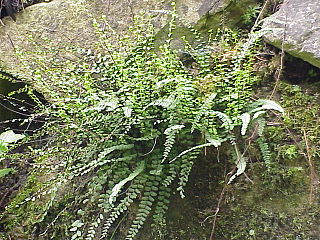
Asplenium is a genus of about 700 species of ferns, often treated as the only genus in the family Aspleniaceae, though other authors consider Hymenasplenium separate, based on molecular phylogenetic analysis of DNA sequences, a different chromosome count, and structural differences in the rhizomes. The type species for the genus is Asplenium marinum.

Asplenium platyneuron, commonly known as ebony spleenwort or brownstem spleenwort, is a fern native to North America east of the Rocky Mountains. It takes its common name from its dark, reddish-brown, glossy stipe and rachis, which support a once-divided, pinnate leaf. The fertile fronds, which die off in the winter, are darker green and stand upright, while the sterile fronds are evergreen and lie flat on the ground. An auricle at the base of each pinna points towards the tip of the frond. The dimorphic fronds and alternate, rather than opposite, pinnae distinguish it from the similar black-stemmed spleenwort.
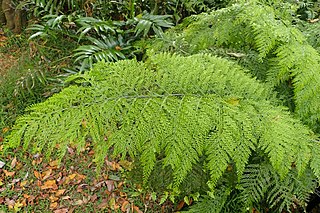
Asplenium bulbiferum, known as mother spleenwort, is a fern species native to New Zealand only. It is also called hen and chicken fern and, in the Māori language, pikopiko, mouku or mauku. Its fronds are eaten as a vegetable.

Asplenium ceterach, also known as the rustyback fern, is a fern species in the spleenwort family Aspleniaceae.

Asplenium trichomanes, the maidenhair spleenwort, is a small fern in the spleenwort genus Asplenium. It is a widespread and common species, occurring almost worldwide in a variety of rocky habitats. It is a variable fern with several subspecies.

Asplenium septentrionale is a species of fern known by the common names northern spleenwort and forked spleenwort. It is native to Europe, Asia and western North America, where it grows on rocks. Its long, slender leaves give it a distinctive appearance. Three subspecies exist, corresponding to a tetraploid and a diploid cytotype and their triploid hybrid.
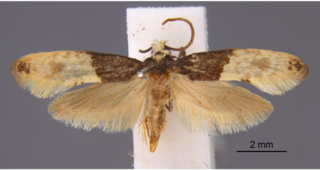
Trichophaga tapetzella, the tapestry moth or carpet moth, is a moth of the family Tineidae, commonly referred to as fungus moths. It is found worldwide.

Tinea pellionella, the case-bearing clothes moth, is a species of tineoid moth in the family Tineidae, the fungus moths. This species has a cosmopolitan distribution, occurring nearly worldwide.

Asplenium montanum, commonly known as the mountain spleenwort, is a small fern endemic to the eastern United States. It is found primarily in the Appalachian Mountains from Vermont to Alabama, with a few isolated populations in the Ozarks and in the Ohio Valley. It grows in small crevices in sandstone cliffs with highly acid soil, where it is usually the only vascular plant occupying that ecological niche. It can be recognized by its tufts of dark blue-green, highly divided leaves. The species was first described in 1810 by the botanist Carl Ludwig Willdenow. No subspecies have been described, although a discolored and highly dissected form was reported from the Shawangunk Mountains in 1974. Asplenium montanum is a diploid member of the "Appalachian Asplenium complex," a group of spleenwort species and hybrids which have formed by reticulate evolution. Members of the complex descended from A. montanum are among the few other vascular plants that can tolerate its typical habitat.
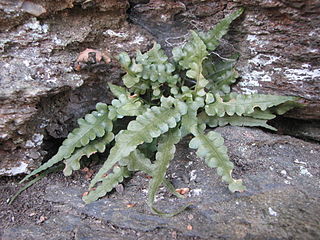
Asplenium pinnatifidum, commonly known as the lobed spleenwort or pinnatifid spleenwort, is a small fern found principally in the Appalachian Mountains and the Shawnee Hills, growing in rock crevices in moderately acid to subacid strata. Originally identified as a variety of walking fern, it was classified as a separate species by Thomas Nuttall in 1818. It is believed to have originated by chromosome doubling in a hybrid between walking fern and mountain spleenwort, producing a fertile tetraploid, a phenomenon known as alloploidy; however, the hypothesized parental hybrid has never been located. It is intermediate in morphology between the parent species: while its leaf blades are long and tapering like that of walking fern, the influence of mountain spleenwort means that the blades are lobed, rather than whole. A. pinnatifidum can itself form sterile hybrids with several other spleenworts.

Asplenium bradleyi, commonly known as Bradley's spleenwort or cliff spleenwort, is a rare epipetric fern of east-central North America. Named after Professor Frank Howe Bradley, who first collected it in Tennessee, it may be found infrequently throughout much of the Appalachian Mountains, the Ozarks, and the Ouachita Mountains, growing in small crevices on exposed sandstone cliffs. The species originated as a hybrid between mountain spleenwort and ebony spleenwort ; A. bradleyi originated when that sterile diploid hybrid underwent chromosome doubling to become a fertile tetraploid, a phenomenon known as allopolyploidy. Studies indicate that the present population of Bradley's spleenwort arose from several independent doublings of sterile diploid hybrids. A. bradleyi can also form sterile hybrids with several other spleenworts.

Batrachedra psithyra, the spleenwort spore-eater, is a species of moth of the family Batrachedridae. It is endemic to New Zealand. This species has been observed in the North, South and Matiu / Somes Islands. This species inhabits overgrown grasslands or fern glades and have also been observed in gumland heath. The larvae of this species feed on fern sori including those on Histiopteris incisa. Adults are on the wing from November to January and tends to fly at sunset. At rest this species raises the front part of its body and when moving waves alternate antennae.

Asplenium resiliens, the blackstem spleenwort or little ebony spleenwort, is a species of fern native to the Western Hemisphere, ranging from the southern United States south to Uruguay, including parts of the Caribbean. Found on limestone substrates, it is named for its distinctive purplish-black stipe and rachis. A triploid, it is incapable of sexual reproduction and produces spores apogamously. First described by Martens and Galeotti in 1842 under the previously used name Asplenium parvulum, the species was given its current, valid name by Kunze in 1844. Several similar species are known from the tropics; A. resiliens may have arisen from these species by reticulate evolution, but precise relationships among the group are not yet certain.

Tinea pallescentella, the large pale clothes moth, is a moth of the family Tineidae. It is found in most of Europe. It is also present in western North America, where it has been recorded from California. There are also records from South America and Australia.

Nemapogon ruricolella, the gold-sheen clothes moth, is a moth of the family Tineidae. It is found in Great Britain, Spain, France, the Netherlands, Germany, Austria, Switzerland, Italy, the Czech Republic, Albania, Bulgaria, Romania, Moldova, Greece, Ukraine and Russia, as well as on Sardinia. The habitat consists of woodlands, heathlands and commons.
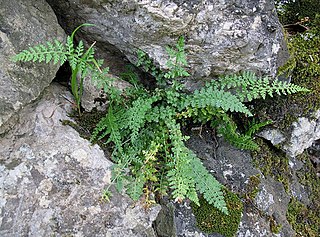
Asplenium fontanum, commonly known as fountain spleenwort or smooth rock spleenwort, is a species of fern in the family Aspleniaceae, native to rocky areas in Western Europe.
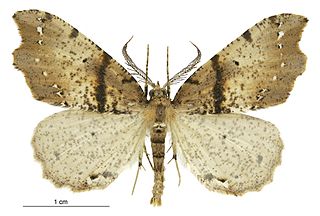
Chalastra pellurgata, also known as the brown fern moth or the pale fern looper, is a moth of the family Geometridae. This species was first described by Francis Walker in 1862. It is endemic to New Zealand and can be found throughout the country. It inhabits native forest. This species is extremely variable both in its larval and adult life stage. Larvae of this species are active during spring and summer. They feed on the fronds of fern species. C. pellurgata pupates by forming a thin cocoon on the soil amongst leaf litter and moss. Adults are on the wing throughout the year but are most common from September to March. During the day adult moths can be observed resting on dead fern fronds. They become active from dusk and are attracted to light.
Psychoides is a genus of moths belonging to the family Tineidae. The type species is Psychoides verhuella first described by, the French entomologist, Charles Bruand in 1853. Bruand also erected the genus.
Psychoides gosari is a moth of the family Tineidae first described by Seok Kim and Yang-Seop Bae in 2007 from pupae collected from Mount Hwaya in Gyeonggi Province. It is endemic to South Korea.

Psychoides verhuella is a moth of the family Tineidae found in Europe. It was first described in 1853, by Charles Théophile Bruand d'Uzelle from a specimen from Besançon, France. It is the type species of the genus Psychoides, also raised by Charles Bruand in 1853. The larvae feed on ferns.



















